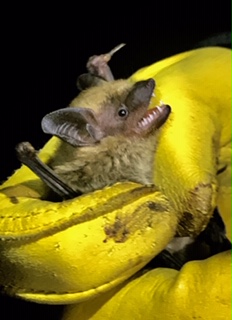Maternity roosts, delayed ovulation and mating swarms: Protecting the (truly weird) reproductive cycle of bats.
Story by: Alison Levine, Communications Coordinator
Bats. They can be kind of creepy. Full disclosure, when I was a kid a bat got into our house and was so disoriented at being in an alien environment that it actually flew into my shoulder. So, I’m not exactly unbiased. I’ve learned to appreciate the important roles bats play – many help keep insect populations under control, some are crucial pollinators for fruits – but I’ve never really warmed up to them before.
While there are plenty of people who share my slightly-creeped out feelings for bats, fortunately there are lot of people who love the furry little flying mammals.

CWF Biologist, and bat ambassador extraordinaire, Meghan Kolk goes out and handles bats on purpose. As part of a joint project with the U.S. Fish and Wildlife Service (USFWS) Meghan and CWF Biologist Ethan Gilardi teamed up with USFWS staff to conduct bat surveys in the summer of 2018 and again this year.
The surveys are conducted at Joint Military Base McGuire-Dix-Lakehurst in the northern part of Pine Barrens. The goal is to capture northern long-eared bats (Myotis septentrionalis), a federally threatened species, and track them back to their roost tree (ideally tracking females back to maternity roost trees) using radio transmitters.
Photo of big brown bat by John King
A note about maternity roost trees here. As it happens, bats’ family lives sound like something straight out of a science fiction movie.
Mating season for bats in temperate climates (like New Jersey) starts in the fall with a “mating swarm” near their hibernation site. The females then store the sperm while they hibernate for the winter, delaying ovulation until after waking in the spring or early summer when food is available.
So, we already have a mating swarm, sperm storage, and delayed ovulation. Then, the pregnant females get together and set up a communal roosting site – or maternity colony – in maternity roost trees, where they give birth, nurse and wean their pups. The males mostly roost alone or in loose groups separately from the females.
These maternity colonies are often in dead or dying trees with flaking bark. Bat moms tuck themselves, and their pups, in under the loose bark to share body heat, as growing pups need the extra warmth. At sunset, the females emerge to forage, leaving the pups behind.

In addition to sharing heat, a maternity colony can also provide the advantage of safety in numbers. However, a potential disadvantage of a large maternity colony is that a lot of bat moms emerging together at sunset can attract predators. Bats have no shortage of predators, including hawks, owls, snakes, weasels and racoons. A predator keying in on a maternity colony could be devastating, especially to an endangered or threatened species.
Generally, bats have site fidelity and will return to the same roost trees year after year if they remain suitable. However, to avoid detection by predators some bat moms may use multiple roost trees throughout the season, carrying their pups from one tree to another.
Because too much disturbance can cause mothers to abandon a maternity tree, it is important for biologists to identify and protect them.
While northern long-eared bats are the primary subject of these surveys, biologists also want to track little brown bats (Myotis lucifugus) and tri-colored bats (Perimyotis subfavus) back to their roost trees. Their populations are currently in steep decline and they will likely be federally listed as threatened in the future.
All three species are in trouble due to White-Nose Syndrome (WNS), which is responsible for the death of millions of bats nationwide.
The surveys are conducted via mist netting – stretching a delicate net between two poles meant to be virtually invisible. Mist nets are stretched across corridors in the woods, or across streams where bats would normally travel without obstructions.

Photos courtesy of Stephanie Feigin, CWF.
Biologists set up roughly 5 nets per night, for 10 nights, just after sunset and then check them every 10 minutes for 5 hours. When a bat is caught, it is carefully detangled from the net and processed immediately. (This is the part when the biologists are handling the bats on purpose!)
All netted bats are identified by species, sexed, aged, weighed and measured. Their reproductive status is determined and their wings are checked for evidence of damage from WNS. Long-eared, little brown and tri-colored bats are also banded on their forearm and fitted with a transmitter that allows biologists to track them by radio telemetry.

Photo courtesy of Stephanie Feigin, CWF.
The target species are extremely hard to net, due to their very small populations. While one northern long-eared bat was captured in 2018, it escaped the net before it could be retrieved and fitted with a transmitter.
Non-target bats, with their larger populations are much easier to net. Many big brown bats (Eptesicus fuscus) and eastern red bats (Lasiurus borealis) have been netted over the course of the survey, plus one hoary bat (Lasiurus cinereus).
The 2019 bat survey will be completed in the middle of August. Hopefully we’ll net a female northern long-eared bat so she can be tracked back to her maternity roost. With populations low, and continuing to decline, every roost tree we can protect will make a big difference for the survival of this wonderful, fascinating little mammal.
For more information on CWF’s bat work, visit our Bat Project page.
Discover more from Conserve Wildlife Foundation of NJ
Subscribe to get the latest posts sent to your email.